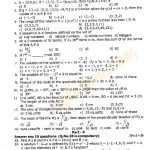Chemistry is a central science that plays a crucial role in our understanding of the material world. For students in their first year of BSc, it lays the foundation for advanced concepts that they will encounter in the coming years. In BSc 1st Year Chemistry, students are introduced to a wide range of topics, from the structure of atoms to the complex reactions in organic chemistry. Mastering these topics is essential not only for passing exams but also for building a strong base for future studies in chemistry.
This article provides detailed notes for BSc 1st Year Chemistry, covering all the essential topics that students will encounter in their syllabus. These notes are structured in a way that makes them easy to understand, yet comprehensive enough to prepare for exams. The topics covered include atomic structure, chemical bonding, thermodynamics, chemical kinetics, organic chemistry, and more. The notes also include study guides, textbook summaries, sample problems, and exam preparation materials to help students gain a solid grasp of the subject. Each section is written in simple, clear language, making it easier for students to follow along and learn effectively.
By the end of these notes, students will be well-prepared to tackle their chemistry exams with confidence and a deep understanding of the material. Let’s dive into the detailed notes for each topic.
[save_as_pdf_pdfcrowd]
Topics to Be Covered:
- Atomic Structure
- Chemical Bonding
- Periodic Table and Periodicity in Properties
- Thermodynamics
- Chemical Kinetics
- Equilibrium
- States of Matter
- Electrochemistry
- Organic Chemistry – Basics and Alkanes
- Stereochemistry
- Isomerism in Organic Chemistry
- Functional Groups: Alcohols, Ethers, Aldehydes, Ketones
- Environmental Chemistry
- Chemical Analysis Techniques
Lecture Notes
Atomic Structure
The study of atomic structure is fundamental to understanding chemistry. The atom consists of three primary particles: protons, neutrons, and electrons. Protons are positively charged, neutrons have no charge, and electrons are negatively charged. The nucleus, which contains protons and neutrons, is at the center of the atom, while electrons orbit the nucleus in defined energy levels or shells.
In atomic structure, one of the key models is Bohr’s model, which describes how electrons occupy specific energy levels. When electrons gain energy, they move to a higher energy level, and when they lose energy, they fall back to a lower energy level, emitting light in the process. This emission of light can be observed in atomic spectra, which is unique for each element.
The quantum mechanical model of the atom provides a more accurate description of the atom’s structure. According to this model, electrons are found in regions of space known as orbitals. These orbitals are described by four quantum numbers: the principal quantum number (n), the azimuthal quantum number (l), the magnetic quantum number (m), and the spin quantum number (s). These quantum numbers help determine the size, shape, and orientation of the orbitals.
Chemical Bonding
Chemical bonding refers to the attractive forces that hold atoms together to form molecules. There are three main types of chemical bonds: ionic, covalent, and metallic.
- Ionic bonds: These are formed when one atom donates an electron to another atom, resulting in the formation of positively and negatively charged ions. The electrostatic attraction between these oppositely charged ions forms the bond. For example, in sodium chloride (NaCl), sodium donates an electron to chlorine, forming Na+ and Cl- ions.
- Covalent bonds: In covalent bonds, atoms share electrons to achieve a stable electron configuration. This type of bonding occurs mainly between non-metal atoms. For example, in a water molecule (H2O), each hydrogen atom shares an electron with the oxygen atom, resulting in covalent bonds.
- Metallic bonds: Metallic bonding occurs in metals, where electrons are shared collectively by a lattice of metal atoms. This type of bonding gives metals their characteristic properties, such as conductivity and malleability.
The concept of VSEPR theory (Valence Shell Electron Pair Repulsion theory) helps predict the shapes of molecules based on the repulsion between electron pairs in the valence shell of atoms. For example, methane (CH4) has a tetrahedral shape because the four pairs of electrons around the carbon atom repel each other equally.
Periodic Table and Periodicity in Properties
The periodic table is an organized arrangement of elements based on their atomic number. Elements in the same group (vertical columns) have similar chemical properties because they have the same number of valence electrons. The table is divided into metals, non-metals, and metalloids.
Periodic properties are trends in the properties of elements that can be observed across the periods (horizontal rows) and groups of the periodic table. Some key periodic properties include:
- Atomic radius: The size of an atom decreases across a period from left to right and increases down a group.
- Ionization energy: The energy required to remove an electron from an atom. Ionization energy increases across a period and decreases down a group.
- Electronegativity: The tendency of an atom to attract electrons in a chemical bond. Electronegativity increases across a period and decreases down a group.
These trends are explained by the effective nuclear charge, which increases across a period due to the increasing number of protons in the nucleus.
[save_as_pdf_pdfcrowd]
Thermodynamics
Thermodynamics is the study of heat and energy transfer in chemical reactions. It includes the laws that govern energy changes in systems and surroundings.
- The first law of thermodynamics (also known as the law of conservation of energy) states that energy cannot be created or destroyed, only converted from one form to another. The internal energy of a system changes due to heat exchange and work done on or by the system.
- Enthalpy (ΔH) is a measure of the heat content of a system at constant pressure. It is used to quantify the heat absorbed or released during a chemical reaction. Reactions where heat is absorbed are called endothermic (ΔH > 0), while reactions where heat is released are exothermic (ΔH < 0).
- Entropy (ΔS) is a measure of the disorder or randomness in a system. Processes that increase disorder (such as the melting of ice into water) have a positive entropy change.
- Gibbs free energy (ΔG) combines enthalpy and entropy to determine whether a process is spontaneous. A negative value of ΔG indicates a spontaneous process.
ΔG=ΔH−TΔS\Delta G = \Delta H – T\Delta S
Chemical Kinetics
Chemical kinetics is the study of the speed or rate of chemical reactions. Several factors influence the rate of a reaction, including temperature, concentration, surface area, and the presence of catalysts.
- Rate laws describe how the rate of a reaction depends on the concentration of the reactants. For a reaction A + B → C, the rate law may be expressed as:
Rate=k[A]m[B]n\text{Rate} = k [A]^m [B]^n
where k is the rate constant, and m and n are the orders of the reaction with respect to A and B, respectively.
- Activation energy (Ea) is the minimum energy required for a reaction to occur. The Arrhenius equation relates the rate constant (k) to the temperature (T) and activation energy:
k=Ae−Ea/RTk = A e^{-E_a / RT}
where A is the frequency factor, R is the gas constant, and T is the temperature.
Equilibrium
Chemical equilibrium occurs when the rates of the forward and reverse reactions are equal, meaning the concentrations of reactants and products remain constant over time. The equilibrium constant (K) is used to express the ratio of the concentrations of products to reactants at equilibrium.
K=[Products]/[Reactants]
- Le Chatelier’s Principle states that if a system at equilibrium is disturbed, the system will shift to counteract the disturbance. For example, increasing the concentration of reactants will shift the equilibrium toward the products.
States of Matter
Matter exists in three main states: solid, liquid, and gas. The behavior of gases is described by the ideal gas law:
PV=nRTPV = nRT
where P is pressure, V is volume, n is the number of moles, R is the gas constant, and T is temperature.
- Liquids have a definite volume but take the shape of their container. The forces between molecules in a liquid (intermolecular forces) determine properties like surface tension and viscosity.
- Solids have a fixed shape and volume. The arrangement of particles in a solid can be crystalline (ordered) or amorphous (disordered).
Electrochemistry
Electrochemistry deals with redox (oxidation-reduction) reactions, where electrons are transferred between species. Key concepts include:
- Galvanic cells: These generate electrical energy from spontaneous redox reactions. For example, in a zinc-copper cell, zinc is oxidized (loses electrons) at the anode, and copper is reduced (gains electrons) at the cathode.
- Electrolysis: This process uses electrical energy to drive non-spontaneous reactions. For example, water can be electrolyzed to produce hydrogen and oxygen gas.
[save_as_pdf_pdfcrowd]
Latest Posts
- Step-by-step guide to download and apply for jee mains admit card 202
- Comprehensive 2025 government holidays and recruitment details for job seekers
- JEE Mains Admit Card 2025: Your Step-by-Step Guide to Downloading the Hall Ticket
- Everything You Need to Know About 2025 Government Holidays Recruitment
- Comprehensive Guide to rrb d group recruitment 2025 – Eligibility, Vacancies, and Application
- Detailed guide to nps trust recruitment 2025 vacancies, eligibility and apply process
- Comprehensive guide to hpcl recruitment 2025 notification, vacancies, and application process
- ignou bed admission 2025 complete recruitment guide with eligibility and process
- Comprehensive Guide to Indian Army Agniveer Recruitment 2025 Notification and Jobs
- Everything You Must Know About CBSE Board Exams 2025 Changes & New Rules






